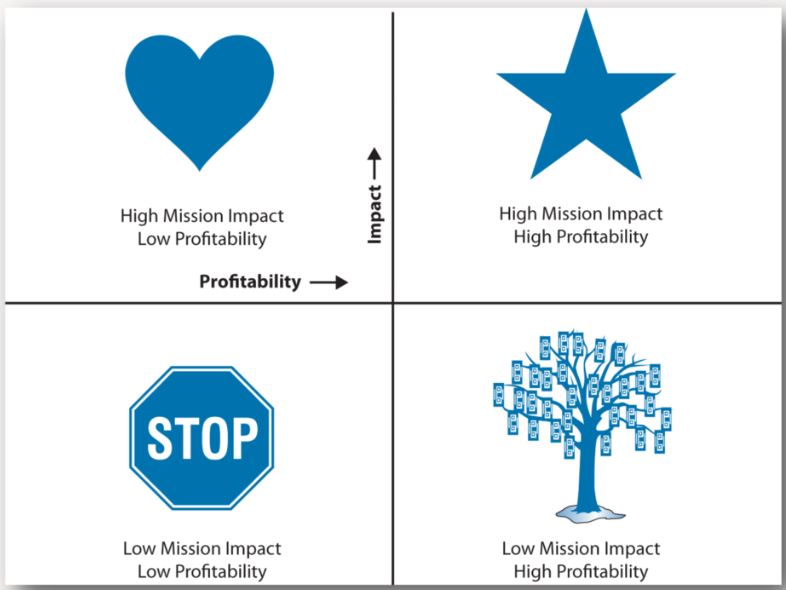With changes in technology, changes in business models, and changes in expectations from seemingly every player in the scholarly communications ecosystem, it’s easy to feel overwhelmed. How do you prioritize choices? What can wait and what can’t? When is the right time to implement some new content or process innovation? And which ones should you just sit back and watch?
To consider this issue more fully, this month we asked the Chefs: How can organizations prioritize the myriad of demands on their time and resources?

Alice Meadows: The obvious answer is to focus. To always stay true to what Barack Obama and others refer to as your North Star: your organization’s one overall goal. But of course that’s easier said than done.
First, and most importantly, you need to reach agreement on what your North Star is. And no, you can’t have more than one. So you’ll have to think very carefully before making that decision. This means being brutally honest about the purpose of your organization: why does it exist? who do you serve? what does that mean for your priorities, past, present, and future?
…being brutally honest about the purpose of your organization: why does it exist? who do you serve? what does that mean for your priorities, past, present, and future?
Second, you need to ensure that everyone in your organization — and ideally, your wider community — understands and supports you; that they believe you’re focusing on the right North Star.
Third — another major challenge — you must not get distracted! Having worked in both a large commercial organization (Wiley) and a small not-for-profit (ORCID, my current organization), my experience is that both types are equally prone to distraction, often for the same, very understandable reasons. There may be a new opportunity that’s impossible to resist or an unexpected threat that’s equally impossible to ignore. But if your organization is navigating based on its true North Star then, while those “distractions” may cause you to navigate in different ways, your focus should remain the same. If not, then perhaps your North Star wasn’t so true after all…
Joe Esposito: Organizations that perceive a myriad of demands on their time and resources are already dead. There is only one demand on any organization: How to navigate the future. Anything that distracts the management from that imperative is working in the service of the competition.
Judy Luther: While individuals can use techniques for ordering day to day activities, organizations benefit from adopting a framework that serves their long-term goals. One option that organizations find useful is the Matrix Map developed by Steve Zimmerman and Jeanne Bell, authors of The Sustainability Mindset published in 2015 by Jossey-Bass. It provides a framework for assessing all the organization’s activities in terms of finances and mission. The map puts profitability and impact on two axes. The visual presentation combines these two elements and can provide insights and ‘aha’ moments that support strategic discussions.

The process of populating this map begins with an articulation of the strategic issues facing the organization. The organization must define impact criteria for scoring current programs and gather data on the programs and their profitability. The numerical results are used to create the Matrix Map which has four quadrants. The Heart is core to the organization and requires cost management. The Star represents opportunities for possible expansion. The Money Tree raises questions about increasing impact and reducing costs. The Stop Sign questions the use of the resources.
As non-profit organizations, societies depend upon volunteers in leadership roles. Since there is the implicit assumption that all programs are worthwhile, there is a reluctance to offer critical judgements. Elected boards turn over on a regular basis and typical board meetings have reports on finances followed by reports on programs. This approach makes it difficult to gain important insights. The use of the Matrix Map as a planning tool can benefit societies by engaging the leadership and stakeholders in an assessment of existing programs that brings clarity to current operations and can serve as a catalyst for change.
Lettie Conrad: Prioritization is the name of the game these days, as technological innovation and ever-changing information practices accelerate the rate of change in our industry. We simply cannot respond to every new initiative and headline. Whether I’m conducting a discoverability audit or designing a new interface, the question of where to best apply our precious time and energy resources is at the heart of nearly all R&D projects I take up with content / service providers.
Prioritization is the name of the game these days, as technological innovation and ever-changing information practices accelerate the rate of change in our industry. We simply cannot respond to every new initiative and headline.
For myself and my peers, articulating a “North-star” can immediately cut through the hubbub of never-ending email and the crush of social media, offering a clear direction to guide our work. In fact, Dieter Ram’s design principles shared last week does just that: clarify the prevailing focus as the consumer and their “job to be done”. Through various research methods, we can achieve an operational understanding of the people we serve and their content tasks and needs, making them our guiding light in decision making.
Through various research methods, we can achieve an operational understanding of the people we serve and their content tasks and needs, making them our guiding light in decision making.
Leveraging this knowledge, I often put the humans in the spotlight — such as students or librarians or clinicians — and allow careful attention to these realities guide what matters for digital product development. For some organizations, it will be specific constituents, like society members or research faculty. For many, it will be a nuanced combination of both customers and end-users, where some natural tension exists and must be negotiated. But for all of us, this is an ongoing exercise, as we must remain open to the liminal nature of information experiences and regularly adapt to what we’re learning from our community.
Angela Cochran: This is the $64,000 question. Every organization has dreams of being “this” or offering “that.” What stops organizations from realizing those dreams may be money, or its fickle friend, human resources (which is also a money problem).
When it comes to adding bells and whistles to content sites, some things are no brainers — low effort for integration, reasonable investment, and if the usefulness or uptake is low, you can kill it. The beautiful thing about everyone on the planet being addicted to “free” platforms (i.e., Facebook, Google, and Twitter) is that people are used to features disappearing. Sure, you might get upset if you used that feature all the time, but you get over it, because it didn’t cost you anything in the first place. This allows us to likewise trial new features and kill them if interest is low.
Once the investment (cash and/or human resource) hits a certain threshold, there has to be a significant pay-off, even if the expectation is to break even. If the enhancement is a serious time saver for a user or gives you a competitive advantage, that’s maybe worth the investment. Other times, we are forced to ask ourselves…will we sell more subscriptions with this feature? Can we charge more for the book to recoup those expenses? Are there consequences to not doing this? A “no” to either one of those is not likely to move a project forward.
Other times, we are forced to ask ourselves…will we sell more subscriptions with this feature? Can we charge more for the book to recoup those expenses? Are there consequences to not doing this? A “no” to either one of those is not likely to move a project forward.
By the way, I am going to write a book called “Two Lines of Code.” Every tech integration is described as needing just two lines of code. Often these don’t run on auto-pilot if you want to get the most out of an integrated feature. Resources of the human kind are typically needed.
Stepping outside of the product enhancement area, we take seriously workflow changes and tools that will legitimately make the work of our volunteers easier. We have amazing volunteers that do a lot of work for the society and we owe it to them to provide tools that will save them time.
Todd Carpenter: We all have too much to do and prioritization is critical to staying on top of that to-do list. For organizations, this is equally true. My own organization faces this in spades. There are so many things that NISO could do, for publishers, for libraries, for software companies; and groups are constantly suggesting ideas of efforts to build on. Some projects are large, some small, and focusing time on one effort inevitably means that another will suffer or languish.
Over the years, I have tried to focus our leadership teams on a multi-faceted rubric in supporting or not various projects. The first thing we consider is how closely does this effort align with our greater mission as an organization. For NISO this means, does this serve the larger goals of advancing efficiency, interoperability, or knowledge exchange. We then consider the scale of the impact of this project and the community it will impact. We consider whether project, in the case of NISO, going to impact nearly every publisher or nearly every library, or whether the community impacted is only a few institutions. The smaller the impact, the less likely it will be to advance.
Some projects are large, some small, and focusing time on one effort inevitably means that another will suffer or languish.
Another critical question is how likely this effort is to succeed. Undertaking an effort that is never implemented is worse than not advancing it. Of course, this is not an easy thing to know in advance, but one can often easily identify barriers to success and gauge the intransigence of some who might be opposed to accepting the outcome. One might seek ways to either pass on the work entirely or find ways to partner with others — in a corporate context, perhaps acquire — to accomplish a larger goal. Too often organizations think they can or should pursue an initiative on their own, when partnering with adjacent organizations makes sense.
Too often organizations think they can or should pursue an initiative on their own, when partnering with adjacent organizations makes sense.
Next, one should consider if there are dangers to pursuing a project. Will engaging in this effort put something else at risk? Often there are ways that one might pursue a project that would endanger relationships or partnerships in other areas. That isn’t to say I am risk-averse from the perspective of trying new things that might fail, but rather we consider whether some group be offended or put off by approaching this project. As a consensus body, in particular, one should avoid frustrating constituents.
Finally, I engage a number of people in the decision-making process. While many despise a committee-based decision-making process — and there is much to criticize about it — no one person is keeper of all the wisdom, nor can any one person understand the industry-wide ramifications of a decision. Often committees can be very slow in deliberations, but this too is a signal worth noting. If it takes a comparatively large amount of effort to get a group to decide to do something, then the lack of enthusiasm is a signal about a project’s likelihood to succeed.
Often committees can be very slow in deliberations, but this too is a signal worth noting. If it takes a comparatively large amount of effort to get a group to decide to do something, then the lack of enthusiasm is a signal about a project’s likelihood to succeed.
Jasmine Wallace: The battle against change is constant, fast, and demanding! At times it may appear to be a war that is inevitably lost. However, organizations cannot retreat from the innumerable demands during this time of upheaval. Instead, they can begin to combat the problem by taking a substantial amount of time to prepare, or revisit, a plan to achieve their organizational goals. When beginning to address growing demands, it may not seem like a good time to think about seemingly rigid plans. However, it is difficult to decide what is an urgent or truly pressing requirement for your time and resources when you do not have clear and specific goals already determined.
Benjamin Franklin said it best, “By failing to prepare, you are preparing to fail.” However, do not confuse trusting the process of your plans with being inflexible to changes.
Benjamin Franklin said it best, “By failing to prepare, you are preparing to fail.” However, do not confuse trusting the process of your plans with being inflexible to changes. Plans make you nimbler when the time comes to shift quickly. They take into account what you anticipate needing for the future and can be revised and reevaluated.
Well-developed plans make it easier to decide what you absolutely need to do today, what can be put off until tomorrow, and what can be completely ignored. Planning helps to make sure your resources are being used on the most important jobs, rather than wasting time on less important work. Plans are means of communicating between parties and of ensuring that appropriate strategies, resources, and development procedures are used. Therefore, organizations should have a well-defined outline of their managerial goals; and prioritize what they do, and when they do it, according to the relative importance of each objective.
Organizations should focus on investing time and resources into initiatives that are in alignment with the goals they have identified. The work then becomes not deciding how to prioritize demands being placed upon you, rather to remain consistent with the solutions you’ve already established. Start by pinpointing what you want to achieve and then outline what will help you reach your goals. Then do not react to, or hesitate to cut, any demands that do not align with those goals!
Karin Wulf: My fellow Chefs have such a range of experiences, responsibilities and backgrounds that I’m really looking forward to reading the other responses to this particular question. I’m answering from the perspective of a small, nonprofit humanities organization that does the gamut of society work.
At the Omohundro Institute of Early American History & Culture we publish a journal and books (with our press partners at UNC Press), run conferences and seminars and other events, and award a range of fellowships, some in partnership with organizations such as other research centers and libraries. As Executive Director, I’m always thinking about how and whether what we do meets our mission: to support scholars and scholarship in the history of a capaciously defined early America, and to share that scholarship as widely as possible. Because of the size and scope of the organization, keeping mission in mind as we allocate resources is an every day, every dollar demand. Changes in the economics and practices of our field, scholarly publishing, higher education, and the information economy generally all shape how we decide to continue traditional programs and projects, adapt and revise, or create entirely new ones.
Because of the size and scope of the organization, keeping mission in mind as we allocate resources is an every day, every dollar demand.
If a new project is clearly within our mission, a next question is whether we are the right organization to bring it about. We often collaborate to assist with projects, or partner to help bring it about. Some of our highest profile work right now is the Georgian Papers Programme in which, with our sponsor William & Mary, we are in partnership with the Royal Archives at Windsor Castle and with Kings College London. Digitizing the rich collections of this archive, including a trove of materials from George III, is in keeping with our mission by creating access literally, through the online catalogue, as well as interpretively through academic research and programming. Bringing this material, the texts and the interpretation, to light is a crucial opportunity as we look to the 250th anniversary of the American Revolution in 2026.
A final issue is whether we have the resources to responsibly sustain a project. We can’t and don’t undertake work that we don’t or won’t have the capacity to continue.
Ann Michael: In one way or another, every Chef spoke about focus. Some gave us concrete examples of how they work through prioritization. Several of the Chefs talked about the North Star. Although, she didn’t mention the North Star, the diagram Judy introduced literally has a star to represent activities with high mission impact and high profitability!
We also heard about partnership both from Todd and Karin. In my experience I’ve seen a greater number of societies open to the idea of teaming up or sharing services.
But at the end of the day, it comes down to why you exist. That defines what you hope to accomplish. Then every activity after that can be evaluating by whether or not it is advancing your goals.
Now it’s your turn. How do you feel organizations can (or should) prioritize the myriad of demands on their time and resources?
Discussion
1 Thought on "Ask The Chefs: Prioritizing Organizational Choices"
Excellent collection of answers Ann and chefs, great post, one more suggestion/comment, I’ve noticed; discussing issues/challenges/new technologies with peers, and hence word of mouth/recommendations can also be helpful. There are often early adopters, fast (and slower) followers of new ideas. Do those who take the risk to be first, get the results and a head start, or just also know how to fail fast and are more comfortable with risk and reward.



